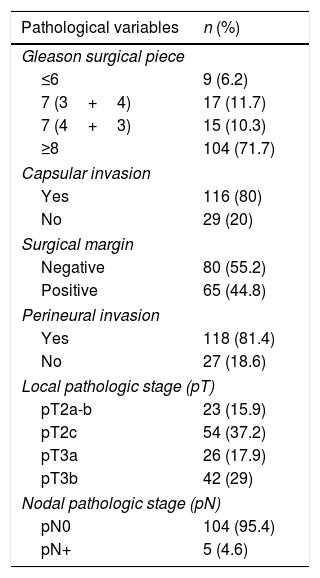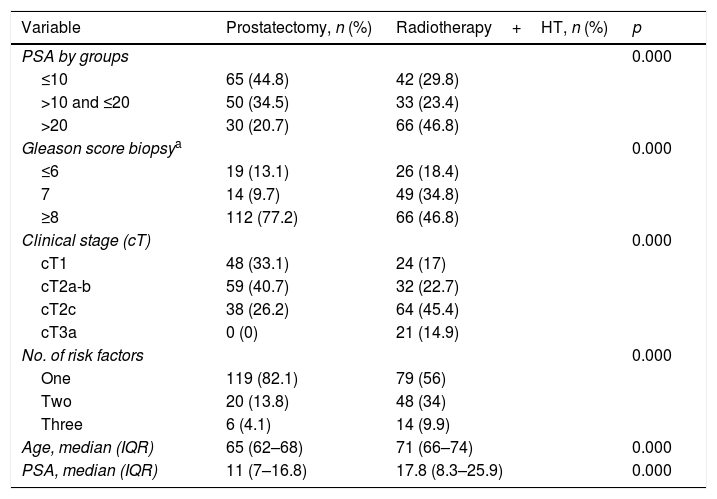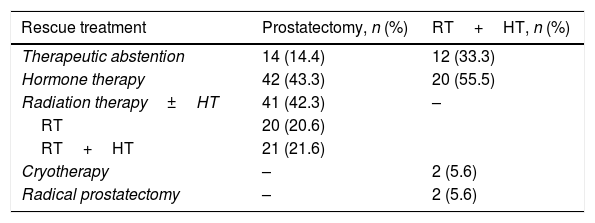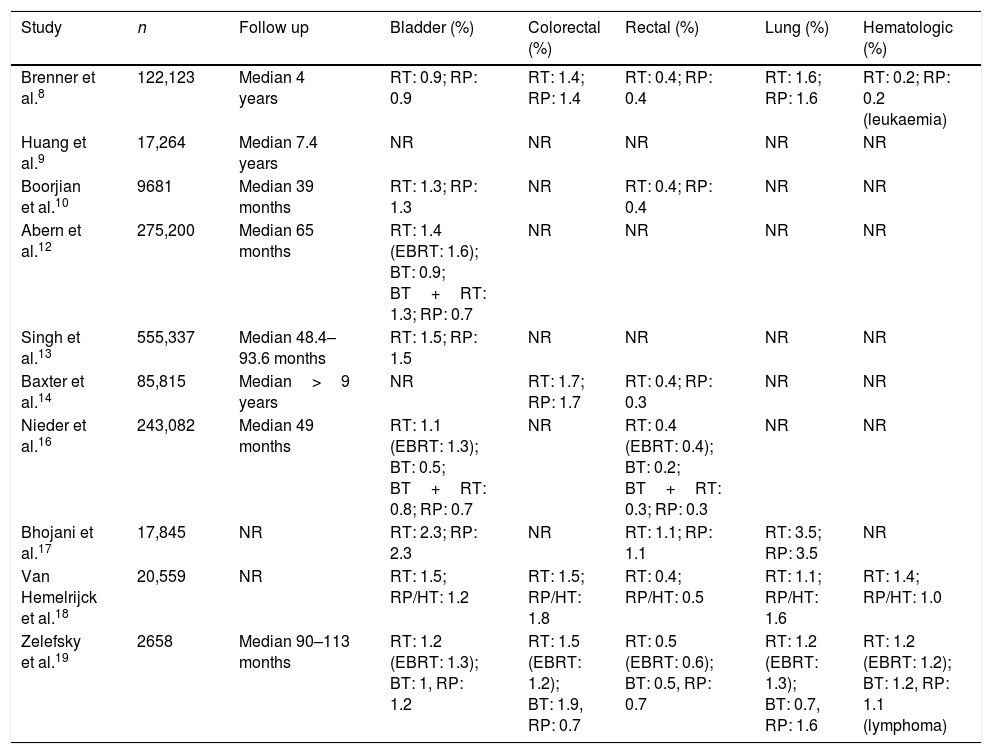The onset of second primary tumours should be considered in high-risk prostate cancer patients in the natural course of the disease. Our aim was to evaluate the influence of primary treatment with curative intent for these patients on the development of second primary tumours.
Material and methodsA retrospective study of 286 patients diagnosed between 1996 and 2008, treated by radical prostatectomy (n=145) or radiotherapy and androgen blockade (n=141). The homogeneity of both series was analyzed using the Chi-squared test for the qualitative variables, and the Student's t-test for the quantitative variables. A multivariate Cox regression analysis was performed to assess whether the type of primary treatment influenced the development of second tumours.
ResultsThe median age was 66 years, and the median follow-up was 117.5 months. At the end of follow-up, 60 patients (21%) had developed a second primary tumour. In the prostatectomy group it was located in the pelvis in 13 (9%) cases, and those treated with radiotherapy and hormonotherapy in 8 (5.7%) cases (p=0.29). The most common organ sites were: colo-rectal in 17 (28.3%) patients, the lung in 11 (18.3%), and the bladder in 6 (10%) patients. In the multivariable analysis, the risk of a second tumour doubled for those treated with radiotherapy and hormonotherapy (HR=2.41, 95% CI: 1.31–4.34, p=0.005) compared to the patients treated by prostatectomy. Age and rescue radiotherapy did not behave as independent predictive factors.
ConclusionsThe onset of a second primary tumour was related with the primary treatment given; thus the risk for those treated with radiotherapy and androgen deprivation therapy more than doubled.
La aparición de segundos tumores primarios en pacientes con cáncer de próstata de alto riesgo debe tenerse en cuenta en la evolución natural de la enfermedad. Nuestro objetivo es evaluar la influencia del tratamiento primario con intención curativa de dichos pacientes en el desarrollo de segundos tumores primarios.
Material y métodosEstudio retrospectivo de 286 pacientes diagnosticados entre 1996 y 2008, tratados mediante prostatectomía radical (n=145) o radioterapia y bloqueo androgénico (n=141). La homogeneidad de ambas series fue analizada con el test de la Chi-cuadrado para las variables cualitativas y la t de Student para las cuantitativas. Se realizó un análisis multivariante mediante regresión de Cox, para evaluar si el tipo de tratamiento primario influía en el desarrollo de segundos tumores.
ResultadosLa mediana de edad fue de 66 años, y la mediana de seguimiento de 117,5 meses. Al final del seguimiento, 60 pacientes (21%) habían desarrollado un segundo tumor primario. En el grupo de prostatectomía se localizó en la pelvis en 13 (9%) casos y en 8 (5,7%) casos en los tratados con radioterapia y hormonoterapia (p=0,29). Las localizaciones más frecuentes por órganos fueron: colorrectal en 17 (28,3%) pacientes, pulmón en 11 (18,3%) y vejiga en 6 (10%) pacientes. En el análisis multivariable, los tratados con radioterapia y hormonoterapia duplicaban el riesgo de segundo tumor (HR=2,41, IC95%: 1,31-4,34; p=0,005) con respecto a los pacientes tratados con prostatectomía. La edad y la radioterapia de rescate no se comportaron como factores predictores independientes.
ConclusionesLa aparición de un segundo tumor primario se relacionó con el tratamiento primario administrado; así, los tratados con radioterapia y privación androgénica multiplicaron por más de 2 su riesgo.
Artículo
Comprando el artículo el PDF del mismo podrá ser descargado
Precio 19,34 €
Comprar ahora












